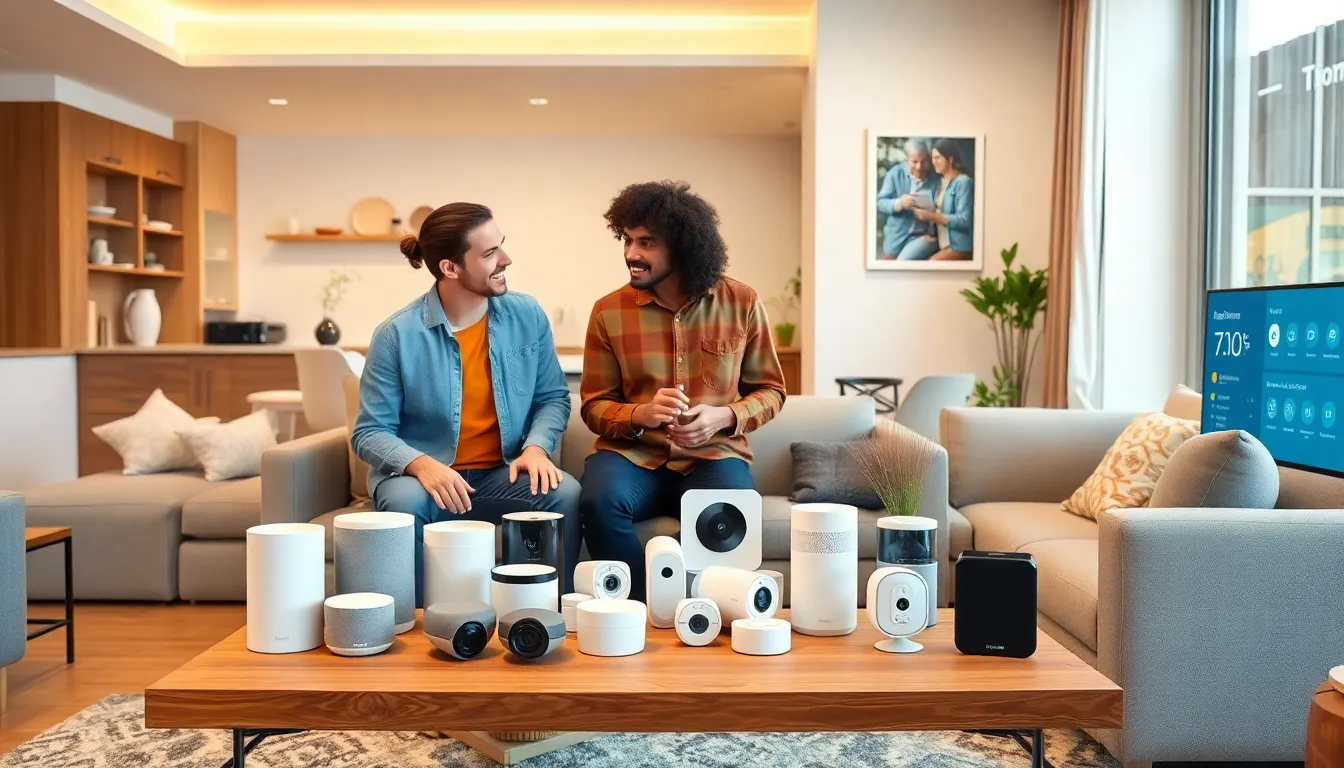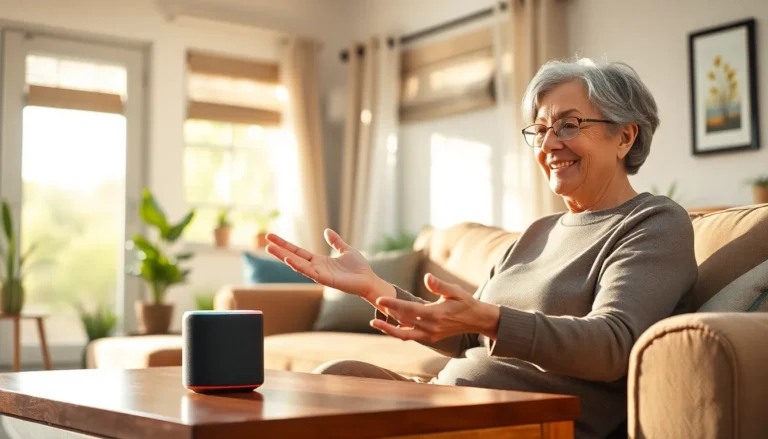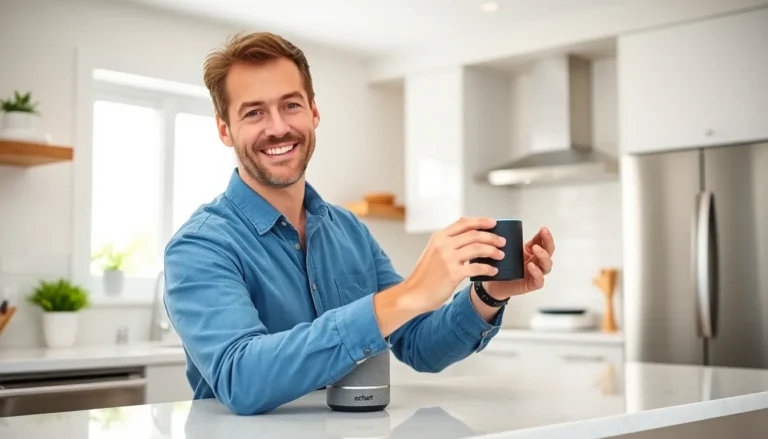Table of Contents
ToggleImagine walking into your home and having the lights dim, the thermostat adjust, and your favorite playlist start playing—all without lifting a finger. Sounds like something out of a sci-fi movie, right? Welcome to the world of smart home devices! These gadgets not only make life easier but also add a sprinkle of magic to the mundane.
Overview of Smart Home Devices
Smart home devices include various products that streamline and enhance household management. Common examples encompass smart speakers, thermostats, security cameras, and lighting systems. These devices connect to the internet, enabling remote control and automation of numerous tasks.
Smart speakers allow users to play music, set reminders, and control other smart devices using voice commands. Thermostats optimize energy usage by learning occupants’ habits and adjusting heating or cooling accordingly. Security cameras provide real-time monitoring, keeping homes safe and allowing users to check in from anywhere.
Smart lighting systems facilitate control over ambiance and energy consumption. Users can remotely adjust brightness or color, and schedule lights to turn on or off automatically. Many devices integrate seamlessly with smartphone applications, providing convenience right at one’s fingertips.
Automation plays a key role in smart home setups. Triggers can be set up so that specific actions execute automatically, such as turning lights on when a resident arrives home. Companies that specialize in smart home technology frequently update their offerings, providing users with the latest features and improvements.
Security measures enhance the functionality of these devices. Encryption and authentication methods ensure that data remains secure during transmission. Users should consider compatibility between different devices for a cohesive setup, as many brands offer proprietary systems.
Smart home devices offer significant potential to improve daily life. Their ability to simplify tasks and improve home security makes them desirable for many homeowners. As technology continues to advance, the variety and capabilities of smart home devices are expected to grow, further enhancing convenience and safety in residential settings.
Planning for Installation

Planning installation of smart home devices requires careful consideration of specific needs and preferences. Identifying key areas in the home that could benefit from automation enhances the overall effectiveness of a smart home setup.
Assessing Your Needs
Take time to evaluate daily routines and tasks that could be streamlined. Understanding how each member of the household uses technology informs device selection. Analyze security concerns that may warrant the installation of smart cameras or alarms. Prioritizing energy efficiency can guide the choice of thermostats, which optimize heating and cooling. Determine the desired level of control, such as remote access or voice commands, to cater to personal preferences.
Choosing the Right Devices
Selecting devices involves assessing compatibility and functionality. Consider the ecosystem of devices already in place to ensure seamless integration. Research brands that offer reliable customer support and regular software updates. Various smart speakers might suit different lifestyles and budgets, affecting the overall experience. Evaluate price ranges while balancing features; investing in quality often yields better long-term satisfaction. Choose devices that align with specific needs and offer the most significant benefit for the home environment.
Installation Process
The installation of smart home devices involves careful planning and execution to ensure optimal performance and compatibility.
DIY Installation Tips
Choosing to install smart home devices yourself can save time and costs. Read the user manual thoroughly before starting. Gather all necessary tools, including screwdrivers, anchors, and a level. Make sure to follow manufacturer instructions closely during setup. Test connectivity by linking devices to the home Wi-Fi network. Utilize mobile apps provided for configuration and updates. It’s advisable to create a dedicated smart home network for added security. Check for firmware updates post-installation for enhanced features.
When to Hire a Professional
Certain installations require expertise beyond basic DIY skills. Complex wired installations, such as security systems or advanced lighting setups, may benefit from a professional. Instances involving electrical work often necessitate a qualified electrician. When dealing with network configurations and integrations, a professional can ensure stability and security. Consider hiring an expert if troubleshooting issues becomes overwhelming. Consulting with a specialist can provide peace of mind and guarantee proper functionality of devices.
Setting Up Smart Home Systems
Setting up smart home systems involves connecting devices seamlessly to enhance automation. Proper installation leads to a more efficient household.
Connecting Devices to Wi-Fi
Connecting devices to Wi-Fi is essential for functionality. Users should ensure their router supports the required frequency bands, typically 2.4 GHz and 5 GHz. Locating devices within range of the router can minimize connectivity issues. Many smart devices have a setup mode that facilitates connecting to the Wi-Fi network, often using an app to guide users through the process. It’s important to enter the correct Wi-Fi password to establish a stable connection. Checking for firmware updates regularly helps maintain performance and security. Strong Wi-Fi signals reduce latency and allow for smoother interactions with devices, making day-to-day automation more reliable.
Utilizing Mobile Apps
Utilizing mobile apps enhances the control users have over smart home devices. These applications serve as central hubs for monitoring and managing settings from anywhere. The initial setup usually requires downloading the respective app for each device. Customizing routines, such as adjusting lighting based on time of day, becomes intuitive. Notifications about device performance, energy consumption, or security alerts keep users informed. Users can create scenes that group multiple devices for cohesive experiences. Regular updates to these apps often introduce new features that improve device interaction and security. Accessing multiple devices through a single application streamlines management, making smart homes easier to navigate.
Troubleshooting Common Issues
Connectivity problems often arise with smart home devices. Users may find that devices fail to connect to Wi-Fi, disrupting routine automation. To resolve this, checking the router’s compatibility with the device’s frequency bands proves essential. Moving devices closer to the router can also improve signal strength.
Power issues can disrupt performance. Devices that aren’t powering on should first be checked to ensure they are plugged in properly. Replacing batteries in wireless devices often restores functionality.
Software malfunctions are another common hurdle. Users may experience unexpected errors during setup. Rebooting the device can clear temporary glitches, while checking for firmware updates ensures optimal operation. Regular updates enhance security and device performance.
When devices are unresponsive, resetting them to factory settings can help. This process often involves pressing a reset button or using the mobile app. Instructions in the user manual provide specifics on resetting individual devices.
Integration difficulties can occur with various brands and protocols. Ensuring device compatibility is vital for smooth operation. Users might need to consult compatibility lists or use a hub that supports multiple device types.
When voice commands fail to trigger devices, checking microphone settings is important. Users should ensure that their voice assistant is functional and listening mode is enabled. Recalibrating voice recognition can also improve responsiveness.
Lastly, if a smart device is not automating tasks as expected, reviewing routine settings is crucial. Users must verify that conditions for automation are met and adjust settings within the app. These steps can enhance the overall smart home experience.
Smart home devices offer a transformative approach to managing daily tasks and enhancing security. With the right planning and installation, users can create a seamless and efficient living environment. By understanding their specific needs and evaluating device compatibility, homeowners can maximize the benefits of automation.
The installation process may seem daunting but following proper guidelines can lead to successful integration. Regular updates and troubleshooting ensure that devices function optimally, providing peace of mind and convenience. Embracing smart home technology not only simplifies life but also opens the door to a more connected and secure future.







